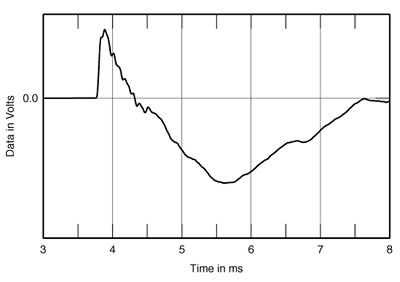

Impact Airfoil 5.2 loudspeaker system
Brian Damkroger, June, 2002

I don't remember what particular treasure I'd been gushing about, but she found it pretty amusing. With two small children, Trish's view of toys consists of Barbies and GameBoys, which she enjoys comparing to my sports cars, motorcycles, and treasured Japanese-pressing jazz LPs.
 I wouldn't characterize my life as "a search for bigger and better toys," but I am intrigued by interesting things—like Impact Technologies' Airfoil 5.2 loudspeaker system. When I first encountered the Airfoil system, at the 2001 WCES, it grabbed my attention for several reasons. The first was its strange appearance. It's a four-tower system, but instead of boxes or panels, the tweeter-midrange units are graceful winglike affairs, with a stack of funny curved, pliable, polymer membranes along their leading edges. And the drivers—assuming that's what those membranes were—pointed at the wall between and behind the speakers!
I wouldn't characterize my life as "a search for bigger and better toys," but I am intrigued by interesting things—like Impact Technologies' Airfoil 5.2 loudspeaker system. When I first encountered the Airfoil system, at the 2001 WCES, it grabbed my attention for several reasons. The first was its strange appearance. It's a four-tower system, but instead of boxes or panels, the tweeter-midrange units are graceful winglike affairs, with a stack of funny curved, pliable, polymer membranes along their leading edges. And the drivers—assuming that's what those membranes were—pointed at the wall between and behind the speakers!
Talking with designer Paul Paddock revealed that those membranes were a genuinely new and patented type of driver (see Sidebar, "Paul Paddock on the Airfoil Bending Wave Driver"). Even the subwoofers—two 12" woofers jammed into an art deco cube—are used in a novel configuration (the subject of another patent application). But the most intriguing thing about the Airfoil system was its sound. Even jammed into a tiny, untreated hotel room, it sounded wonderfully smooth and coherent, and was re-creating a spacious soundstage that completely evaporated the room's walls—and put to shame most of the super systems being shown in more expansive settings.
All that New Technology
The Airfoil's gracefully winglike tweeter-midrange tower actually is constructed like an airplane wing: a curved, veneered surface covers a skeleton of ribs and spars. The towers handle 170Hz up, and each houses nine Bending Wave Drivers. Each driver itself is a thin, clear plastic sheet about 6" tall and 12" wide, wrapped loosely around the wing's leading edge. The front vertical edge of the diaphragm is terminated in a linear voice-coil, and the rear is fastened to the enclosure. The top and bottom edges are unattached. Behind the diaphragms, the cabinet's leading edge is open and filled with damping foam.
At the base of the towers are the Coupling Woofers, which cover the octave from 80Hz to 170Hz. Each channel uses two 6.5" polymer-cone drivers, made by Eminence to Impact's specifications and mounted side by side in a sealed enclosure. A first-order crossover links Bending Wave drivers and woofers.
The subwoofers' drivers are conventional 12" doped paper-cone units, but their Balanced Force Compression loading scheme is unusual. Each subwoofer uses two drivers mounted with their magnets butted up against each other: one fires up, the other down. The drivers are wired in phase, meaning that both cones move outward—away from their magnets—at the same time. But rather than firing into open air, the drivers fire into sealed chambers at the unit's top and bottom. It's the back side of the drivers that communicate with the outside world, through a pair of complex, curved, unequal-length ports that exit through the grille on the tower's front.
The electronic crossover module is pretty straightforward. It has two inputs, with balanced (XLR) and unbalanced (RCA) connections for each. Similarly, the high-pass output—which feeds the user's amplifiers—has both balanced and unbalanced connections. The subwoofer output is balanced only; Impact provides XLO interconnects.
The battery-powered crossover is supplied with a wall-wart charger unit. A front-panel switch toggles between Standby, in which mode the crossover is muted and the batteries are charging, and Operate, which disconnects the charger from the circuit. A nifty LED in the tip of the switch glows red for Standby, green for Operate. Other front-panel controls include Volume, Subwoofer Level, and toggle switches to select between the two inputs and reverse the subwoofer's absolute phase.






